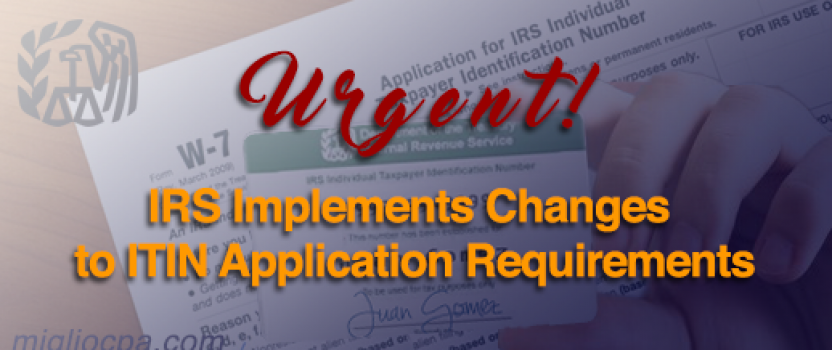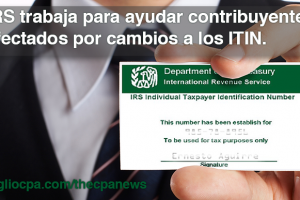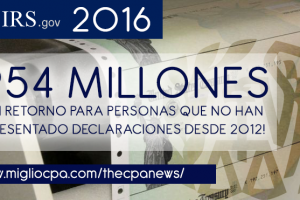IRS Implements Changes To ITIN Application Requirement
IRS Implements Changes to ITIN Application Requirement
Effective January 1, 2013, the IRS implemented new procedures for issuing new Individual Taxpayer Identification Numbers (ITINs). Designed specifically for tax-administration purposes, ITINs are only issued to people who are not eligible to obtain a Social Security Number.
Specifically, the new procedures apply to most applicants submitting Forms W-7, Application for IRS Individual Taxpayer Identification Number. ITINs for individuals in these categories generally are issued during the tax filing season with the submission of a Form 1040, U.S. Individual Income Tax Return.
Questions and Answers
Some Applicants Not Impacted By Changes
Some categories of applicants are not impacted by these changes:
•Military spouses and dependents without an SSN who need an ITIN (Military spouses use box e on Form W-7 and dependents use box d). Exceptions to the new document standards will be made for military family members satisfying the documentation requirements by providing a copy of the spouse or parent’s U.S. military identification, or applying from an overseas APO/FPO address.
•Non-resident aliens applying for ITINs for the purpose of claiming tax treaty benefits (use boxes A and H on Form W-7). Non-resident alien applicants generally need ITINs for reasons besides filing a U.S. tax return. This is necessary for nonresident aliens who may be subject to third-party withholding for various income, such as certain gambling winnings or pension income, or need an ITIN for information reporting purposes. While existing documentation standards will be maintained only for these applicants, scrutiny of the documents will be heightened. ITIN applications of this category that are accompanied by a U.S. tax return will be subject to the new interim document standards.
The October 2, 2012 procedures put into place for the following groups will remain in effect:
•Student and Exchange Visitor Program (SEVP) participants. SEVP participants already provide documentation to the Department of Homeland Security under the requirements of that program. Individuals studying under the SEVP will be required to apply through a university, college or other SEVP-approved institution. These are individuals admitted to the U.S. under an F, J or M visa who receive taxable scholarship, fellowship or other grants reportable by the school on Form W-2 or Form 1042-S. These procedures cover applications for the primary applicant, their spouse and dependents.
•Non-citizens with approved Tax Year 2011 extensions to file their tax returns. These are noncitizens who requested an extension of time to file a 2011 federal income tax return for resident and nonresident aliens and choose to not submit originals documents or copies.
What is the difference between a “certified” and a “notarized” document?
A certified document is one that the original issuing agency provides and certifies as an exact copy of the original document and contains an official stamped seal from the Agency. These documents will be accepted. A notarized document is one that the taxpayer provides to a public notary who bears witness to the signing of the official document and affixes a seal assuring that the document is legitimate. These documents will not be accepted for ITIN applications. Note there are some applicants who are exempt from this change.
Exemption #1- Passive income and third party withholding or tax treaty benefits.
This exception may apply if you are the recipient of partnership income, interest income, annuity income, rental income, or other passive income that is subject to third party withholding or covered by tax treaty benefits. See the Exceptions Tables, later, for more details on Exception 1.
Information returns applicable to Exception 1 may include the following.
Form 1042-S, Foreign Person’s U.S. Source Income Subject to Withholding.
Form 1099-INT, Interest Income.
Form 8805, Foreign Partner’s Information Statement of Section 1446 Withholding Tax.
Schedule K-1 (Form 1065), Partner’s Share of Income, Deductions, Credits, etc.
Applicants receiving compensation for personal services performed in the United States, or issued a U.S. visa that is valid for employment, should first apply for a SSN with the SSA. You are not eligible for an ITIN if you are eligible to get a SSN.
If you are required to file a tax return, then you are not eligible for this exception.
Exception 2. Other income.
This exception may apply if:
1. You are claiming the benefits of a U.S. income tax treaty with a foreign country and you receive any of the following:
a. Wages, salary, compensation, and honoraria payments,
b. Scholarships, fellowships, and grants, and/or
c. Gambling income, or
2. You are receiving taxable scholarship, fellowship, or grant income, but not claiming the benefits of an income tax treaty.
See the Exceptions Tables, later, for more details on
Exception 2. Information returns applicable to Exception 2 may
include Form 1042-S.
Exception 3. Mortgage interest—third party reporting.
This exception may apply if you have a home mortgage loan on real property you own in the United States that is subject to third party reporting of mortgage interest.
See the Exceptions Tables, later, for more details on Exception 3. Information returns applicable to Exception 3 may include Form 1098, Mortgage Interest Statement.
Exception 4. Dispositions by a foreign person of U.S. real property interest—third party withholding.
This exception may apply if you are a party to a disposition of a U.S. real property interest by a foreign person, which is generally subject to withholding by the transferee or buyer (withholding agent). See the Exceptions Tables, later, for more details on Exception 4. Information returns applicable to Exception 4 may include the following.
Form 8288, U.S. Withholding Tax Return for Dispositions by Foreign Persons of U.S. Real Property Interests.
Form 8288-A, Statement of Withholding on Dispositions by
Foreign Persons of U.S. Real Property Interests.
Form 8288-B, Application for Withholding Certificate for
Dispositions by Foreign Persons of U.S. Real Property Interests.
Exception 5. Treasury Decision (TD) 9363.
This exception may apply if you have an IRS reporting requirement under TD 9363 and are submitting Form W-7 with Form 13350.
Note. If you are submitting a passport, or a certified copy from the issuing agency, no other documentation is required to prove your “foreign status” or “identity,” but ensure any visa information shown on the passport is entered on line 6c and the pages of the passport showing the U.S. visa (if a visa is required for your Form W-7) are included with your Form W-7. However, if you are submitting more than one document, enter only the information for the first document on this line. Attach a separate sheet showing the required information for the additional document(s). On the separate sheet, be sure to write your name and “Form W-7” at the top. The “Entry date in United States” must contain the complete date on which you entered the country for the purpose for which you are requesting an ITIN (if applicable). If you have never entered the United States, enter “Never entered the United States” on this line.
Example. You entered the United States on June 1, 2014, to visit. You returned home on July 1, 2014. You then entered the United States on August 1, 2014, to work for Company X. You want to file a return for the income you earned in the United
States in 2014. You are not eligible to get a social security number. You file Form W-7 with your 2014 return. Enter “08/01/2014” on line 6d of Form W-7.
Line 6e. If you ever received an Internal Revenue Service Number (IRSN) or an employer identification number (EIN), check the “Yes” box and complete line 6f. If you never had anIRSN or an EIN, or you do not know your IRSN, check the “No/Do not know” box.
An IRSN is a nine-digit number issued by the IRS to persons who file a return or make a payment without providing a TIN. You would have been issued this number if you filed a U.S. tax return and did not have a social security number. This IRSN will appear on any correspondence the IRS sent you concerning that return.
An EIN is a nine-digit number (for example, 12-3456789) assigned by the IRS to businesses, such as sole proprietorships.Line 6f. If you have both an IRSN and an EIN, attach a separate sheet listing both. If you were issued more than one IRSN, attach a separate sheet listing all the IRSNs you received. On the separate sheet, be sure to write your name and “Form W-7” at the top.Line 6g. If you checked reason f, you must enter the name of the educational institution and the city and state in which it is located. You also must enter your length of stay in the United States.
If you are temporarily in the United States for business purposes, you must enter the name of the company with whom you are conducting your business and the city and state in which it is located. You also must enter your length of stay in the United States.
Where To Apply By mail.
Mail Form W-7, your tax return (or other documents required by an exception), and the documentation described in item (3) and listed in the chart under How To Apply, earlier to:
Internal Revenue Service
ITIN Operation
P.O. Box 149342
Austin, TX 78714-9342
Source: www.irs.gov







Most Commented Posts